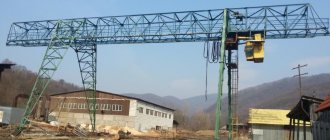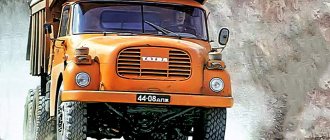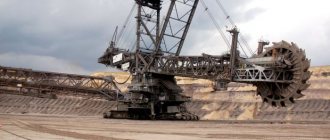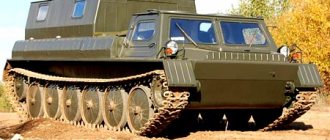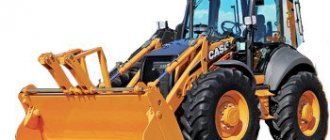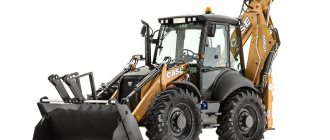Excavator-planner is a type of earth-moving equipment. The design of this vehicle includes a special telescopic boom and a bucket adapted for full rotation. This type of excavator has excellent technical characteristics and relatively small dimensions. All this turns it into a universal special-purpose equipment that can, if necessary, replace several mechanical means at once.
Unit design
- Vehicle chassis 2 is three-axle with drive on pneumatic wheels of the rear axles or with all-wheel drive.
- A rotating platform on which are mounted: a power unit, a crane operator’s cabin, a pressure hydraulic system, and boom equipment. The platform is connected to the frame of the unit through a roller-type rotary support unit.
- The boom mechanism allows the length parameter to be changed during the working cycle. The boom extends and moves, rises and falls. The unit consists of two elements - an external one, fixed on the working platform, and an internal one, on the front of which the controlled actuator equipment is attached.
- Bucket devices are used in several versions, the size and design of which are determined by the specifics of the work operations. The hinge unit ensures rotation of the bucket along its own axis and relative to the axis of the boom mechanism.
- The hydraulic drive ensures the following:
- forward and reverse movement of the bucket device when retracting or releasing the second boom section;
- raising and lowering the boom mechanism vertically;
- rotation of the bucket device on both axes.
During planning operations the following are combined:
- extension or folding of boom elements;
- their rise or fall;
- rotation of the bucket device.
When turning to unload the bucket device, the following are combined:
- raising or lowering boom elements;
- extension of the boom section;
- rotation of the support platform.
Excavator planner operation diagram
1 – crane operator’s cabin; 2 – rotary support platform; 3.4 – main and retractable sections of the boom mechanism; 5 – bucket device. Lc – variable extension parameter; Hk – digging depth; Hв – unloading height; Rк – digging radius.
Angles: α and β – lifting and lowering of the boom mechanism; Y – rotation of the bucket device.
Working conditions and use of electronic signatures.
EPs occupy a small part of the excavator fleet, however, due to their capabilities in creating vertical and inclined walls from soil, they are indispensable on various types of construction sites. During various works on the construction of gas pipelines, EPs are widely used as universal means for refining the walls of trenches for pipelines. The main criteria when choosing an electric drive are: bucket capacity, digging depth and unit performance.
All types of electric drives are equipped with a telescopic boom, which ensures linear movement of the working body-bucket during the working stroke of the internal moving part of the telescopic boom, which ensures parallelism of the processed surface to the longitudinal axis of the boom.
Digging pits and trenches for strip foundations requires obtaining side walls of sufficiently high parallelism along the entire length, which is successfully achieved by using EP.
The ability to mobile install various replaceable attachments on the EP, such as buckets of various sizes and purposes, including leveling buckets with a wide working edge, grabs, cargo hooks and a hydraulic hammer, significantly expands the scope of its application.
Technical and operational parameters
| Parameter indicator | Manufacturer | |||||
| "Motovilikha Plants" (Russia) | MP "Svyatovit" (Republic of Belarus) | |||||
| Series designation | EO | E.W. | ||||
| Model designation | 43212 | 43213 | 43214 | 25-M1 | ||
| Platform car | KamAZ | UralAZ | KamAZ | MAZ | ||
| 53228 | 4320-1911-30 | 43118 | 63031 | |||
| Number of axes, including driving ones | 3 | 3 | ||||
| 3 | 2 rear | |||||
| Speed parameters, km/h | 70 | 60 | ||||
| Excavator power plant | Diesel of the Minsk Motor Plant modification D | |||||
| 243L | 245L | |||||
| Power parameter, kW | 57,4 | 74,3 | ||||
| Dimensions, m | 8.4 x 2.5 x 3.8 | 9.4 x 2.5 x 3.9 | 8.52 x 2.5 x 3.9 | 8.7 x 2.5 x 3.75 | ||
| Weight of the unit ready for operation, t | 19,6 | 21,1 | 19,6 | 21,77 | ||
| Main bucket device volume, m3 | 0,49 | 0,62 | ||||
| Turn of the bucket device, degrees | ||||||
| by axial fastening | 145 | 155 | ||||
| relative to the boom mechanism | full turn | |||||
| Digging (depth from the level of contact of the vehicle wheels with the ground), m | 5,75 | 5,40 | ||||
| Digging radius, m | 9,2 | 10,35 | ||||
| Acceptable parameter for bucket unloading height, m | 5,75 | 6,1 | ||||
| Boom mechanism extension, m | 3,7 | 4,15 | ||||
| Boom mechanism inclination at angles, degrees: top position bottom position | 30 70 | 30 60 | ||||
| Rate of operation (work cycle), s | 21 | 22 | ||||
| Output, m3/h | 91 | 94 | ||||
| Loads, kN: | ||||||
| when turning the bucket device | 91 | 81 | ||||
| the boom mechanism is complicated | 99 | |||||
| Hydraulic system pumping unit pressure, MPa | 25 | 29 | ||||
Ballast scheduler device
In Fig. 1. The general view of the machine is shown:
Fig.1 Ballast scheduler
1-frame; 2-wheel pair; 3-spring suspension; 4-automatic coupler; 5-cabin; 6-central plow; 7 side plow; 8-tunnels; 9-pickup
Welded frame 1, spring suspension 3. Automatic couplers 4 are installed at the ends of the frame. At the rear end of the frame there is a cabin 5, in which equipment for controlling the machine in transport and working modes is installed. On the frame, in the base of the machine, there is a central plow 6, side plows 7 and tunnels 8. A pick-up 9 is installed under the cab. A power drive with a reverse transfer case and a gearbox are mounted on the frame, which are connected by cardan shafts to the axial gearboxes of the wheel sets.
Actuator
The power drive ensures the movement of the ballast planer in transport and operating modes, and also turns on the hydraulic system pumps. The kinematic diagram of the power drive is shown in Fig. 2.
The power drive consists of an engine with a clutch 1, on which a gearbox 2 is flanged, the latter is connected through a cardan 23 to a reverse transfer case 3. From the front end of the engine shaft, a compressor 4 rotates through a V-belt drive, designed to operate the pneumatic system of the machine.
Fig.2 Kinematic diagram of the power drive
1-engine; 2-gearbox; 3-reverse transfer case; 4-compressor; 5,6,7,8,9-pumps; 10,11,14,21 couplings; 12,18-hydraulic motors; 13,19 wheel pairs; 15-reverse clutch; 16,23,24 - cardan shafts; 17.22-axis gearboxes; 20-gearbox.
On the reverse transfer case 3 there are five pumps 5, 6, 7, 8 and 9, which are the power source for the hydraulic cylinders of the working bodies and the hydraulic motors for rotating the brush, the pick-up conveyor and the working movement of the machine.
Clutches 10 and 11 turn on the pumps in operating mode. Hydraulic motor 12 ensures rotation of the front wheel pair, and clutch 14 turns on this hydraulic motor in operating mode. A clutch 15 is installed in the reverse transfer case to reverse movement in transport mode.
The output shaft of box 3 is connected through a cardan 16 to the axial gearbox 17 of the wheel set 13. The second hydraulic motor 18, which ensures rotation of the rear wheel set 19, is installed on the gearbox 20 with clutch 21, which turns off the hydraulic motor in transport mode. The output shaft of the gearbox 20 is connected through the cardan 24 to the axial gearbox 22 of the wheelset 19.
When operating in transport mode, clutches 10, 11, 14 and 21 turn off pumps 5-9 and hydraulic motors 12, 18. The torque from the engine through the clutch and five-speed gearbox 2 is supplied through the cardan 23 to the reverse transfer case 3.
In the reverse transfer case, the reversing clutch 15 is engaged in a certain direction of movement of the machine: “forward” or “backward”. The moment, passing through box 3 and cardan 16, is supplied to the axial gearbox 17 of wheelset 13.
Areas of application
Excavator EW 25-M1
The design features of the main components of leveling excavators have determined earth-moving operations, where the machine is used with maximum efficiency:
- On construction sites of limited size, in places with difficult access and roofed areas.
- For the development of soil mass under bridge structures, during repair work and elimination of accidents in buried communications nodes
- For cleaning the bottom, inclined and vertical walls of trenches, ditches, pits.
- Formation of the base for the installation of floor coverings and foundation elements.
- Finishing fill between foundation elements, ditches, ditches, embankments.
- Delivery of building materials for ceilings through openings and windows in walls.
Excavator-planners Antey: technical characteristics and analogues
A leveling excavator is a special type of construction equipment that is used to perform tasks that are in one way or another related to earthmoving processes. From a structural point of view, the machine is characterized by the presence of a bucket, which is capable of making a full turn, and a telescopic boom.
The vast majority of vehicles of this kind are distinguished by an optimal combination of excellent technical characteristics and relatively small sizes, due to which special equipment is considered universal; if necessary, it can easily replace several machines for different purposes at once.
Executive equipment
Manufacturers supply additional attachments to the special equipment market, including leveling buckets for excavators.
Executive equipment
Bucket devices: 1, 2, 3, 4 – different in volume with a capacity from 0.18 to 0.8 m3; 5 - for planning work on 0.4 m3; 6 - profile type; 7 – trench type; 8 – dump; 9 — board for planning; 10 – loosening device; 11 – gripping device; 12 - picker; 13 — extension of the boom mechanism; 14 – compaction roller.
Golden HandleExcavator Leveler Review
Telescopic boom excavators, or leveling excavators, invented by Americans in the 1940s, occupy a relatively small share of the construction equipment market. There are orders of magnitude more production of conventional universal single-bucket excavators. Moreover, specialized companies deal with planners; no leading engineering company has equipment of this type. The leveling excavator, despite its unique properties, was and remains a niche product.
A straight telescopic boom with a bucket rotation mechanism allows you to easily and quickly plan slopes; thanks to this main property, excavators are called planers. An excavator-planner is usually mounted on a car chassis, which determined its second main property - mobility, which is especially in demand in our open spaces. Mobility fully compensates for the high location of the excavator unit, which reduces such a parameter as digging depth. A leveling excavator, for example, unlike a conventional excavator, can dig under a foundation, under a pipe, under a rubble, which determined its demand among the pillars of the Russian economy - gas workers, oil workers and the Ministry of Emergency Situations.
Additional convenience and speed of operation is provided by the chassis control system from the excavator operator's cab. But for mass excavation work, a leveling excavator is not very convenient. In addition to the automobile chassis, wheeled excavator and tracked ones are also used. A tracked chassis is necessary for working in wetlands, for example, in Western Siberia. In addition, the telescopic boom makes it possible to work in a tunnel.
The capabilities of the planner are expanded by replaceable attachments - buckets of various profiles and capacities, clamshell grab, bulldozer blade, ripper, load hook, vibrating plate, hydraulic hammer, hydraulic shears, drill rod, etc. It is not surprising that the excavator-planner is popularly nicknamed the “golden handle” .
In the USSR in the 1960s, attempts were made to develop and put into production excavator-planners on automobile and wheeled chassis. In the 1970s, these attempts were crowned with success - several models were put into production, but the real fashion for leveling excavators came with the Czech UDS machines on the Tatra chassis. Tatra dump trucks enjoyed well-deserved respect among builders for their high maneuverability and comfortable cabin, which distinguished them favorably from products from the Kama and Minsk factories. And the multifunctional, reliable and aesthetic UDS excavator-planner on a wonderful chassis was the dream of any construction organization.
The Slovak plant Cestne' A Stavebne' Mechanizmy (as the state enterprise "Tisovec Heavy Engineering Plants" became known after corporatization in 1992), despite all the color revolutions, divisions, exits and entries, continues to operate and remains the leading supplier of excavator-planners in Russian market, occupying half of this segment. Today the plant produces four models of leveling excavators – USD 214, UDS 114, USD 232 and UDS 211.
The UDS 114 model has been produced since 1982 and has been modernized more than once over the years. The main chassis is all-wheel drive Tatra T815. The excavator is also installed on the chassis of MAN, Mercedes-Benz, Renault. The Slovak-Russian enterprise "TSSM-Ruslan" (Domodedovo Moscow Region) installs UDS 114 and UDS 214 units on the KamAZ-53228 (6x6) chassis. (Naberezhnye Chelny) installs the UDS 114 excavator on the KamAZ-65111 (6x6) and KamAZ-53228 (6x6) chassis. The basic package of the UDS 114 includes a John Deere engine with a power of 104 kW, the hydraulic system is built on Bosch Rexroth units. The digging depth of a standard two-section box-section boom is 6500...6600 mm, digging radius is 10,500 mm. The figures are impressive. The UDS 114 is not equipped with a chassis control system from the excavator driver's cab or a micro-movement function.
In 1995, the UDS 114 evolved into the UDS 214, but the main chassis remained the same Tatra T815. The unit is equipped with the same John Deere engine, two-section telescopic boom with the same performance characteristics. The main difference from the UDS 114 is the micro-movement function.
CSM Tisovec, in addition to excavators on automobile chassis, produces the UDS 232 model on a wheeled chassis and the UDS 211 on a tracked one with superstructures similar to the UDS 114 and 214. The plant itself does not manufacture the chassis, but orders them from specialized companies.
The boom head of these models is equipped with a full-rotation rotation mechanism and a quick-change mechanism, allowing an experienced operator to change the attachment in a few minutes without leaving the cab. During the production of UDS levelers, the plant has formed a set of the most popular replacement equipment, which includes about 30 items - buckets with a capacity of 0.4 to 0.75 m3, a blade, a roller for soil compaction, a 3 m wide leveling bucket, a combined bucket with a ripper, drainage buckets with a capacity of 0.15 and 0.25 m3, a profile bucket with a capacity of 0.6 m3, a grab, boom extensions 1.5 long; 3.0 and 4.5 m, etc. For equipment from third-party manufacturers: hydraulic hammers, drills, vibratory rammers, mowers, etc., the factory provides special adapters with which the attachment can be installed on the boom head.
The Belarusian enterprise “Svyatovit” (Minsk) was founded in 1997. The plant produced gliders on automobile and tracked chassis under the brands “Svyatovit”, “Antey”, “Hydra”. In total, more than 500 units were produced. excavator equipment. Belarusian excavator-planners occupy about 30% of the Russian market.
In 2010, all brands “Antey” and “Hydra” were abolished, and the modern model range, including a leveling excavator on an EW-25-M1 automobile chassis (S – standard, R – Bosch Rexroth hydraulics, L – Linde hydraulics), Excavator-leveler on a caterpillar chassis (R and L configurations), supplied to the market under the single brand “Svyatovit”.
Excavator-levelers are mounted on the MAZ-6303/MAZ-631705, KamAZ-65111, Ural-4320 chassis. At the STT-2010 exhibition, the plant presented the first excavator on the KamAZ-43118 chassis, an all-wheel drive high-cross-country vehicle with a single-pitch tire. The excavator unit is equipped with a D-245 engine with a power of 100 kW and a hydraulic system built, depending on the configuration, on Bosch Rexroth or Linde equipment. The digging depth of a two-section telescopic box-section boom is 5450 mm, with a 1.5-meter boom extension - 6800 mm, digging radius - 10,450 and 11,800 mm, respectively. The boom head is equipped with a full rotation rotation mechanism and a quick change mechanism. The list of replacement equipment includes buckets with a capacity of 0.4; 0.63; 0.5 and 0.8 m3, blade, grab, roller, three-tooth pick, 2.5 m wide leveling bucket, profile bucket, single-tooth ripper, 2.5 m wide leveling board, combined bucket with ripper.
During the conversion process, Motovilikha Plants began working on road construction equipment, including leveling excavators, the serial production of which the plant began in 1997. Today, Motovilikha brand excavators occupy about 20% of the Russian market. The model range includes excavators on automobile and tracked chassis. The first models put into production, EO-43212 on the KamAZ-53228 chassis and EO-43213 on the Ural-4320 chassis, are still produced by the plant today. Excavator units are equipped with a D-243 engine and an original two-section telescopic boom. The rotation mechanism is not located on the boom tip, but in the main section, and the bucket rotates along with the boom sections. The excavator's digging depth is 5800 mm, digging radius is 9000 mm. The list of replaceable equipment includes a bucket with a capacity of 0.65 m3, a leveling bucket with a width of 1.1 m, a blade with a width of 2 m, trench and drainage buckets, and a single-tooth ripper.
In 2008, the plant launched the ET-4322 model on the KamAZ-43118 chassis. The peculiarity of this model is that the boom support is movable. Thanks to its inclination, the excavator can develop a vertical wall like a conventional excavator, which significantly increases the capabilities of the machine. The boom support is moved by two additional hydraulic cylinders, and no re-installation of the boom is required to tilt it 90°. The ET-4322 uses a two-section box-section boom with a rotation mechanism on the tip. Digging depth – 6900 mm, digging radius – 11,300 mm. In 2010, the excavator received a new, more comfortable cabin with improved visibility.
TVEX is both a new and not new name on the market of leveling excavators. The Kalinin Excavator Plant was developing and producing planners on its own wheeled chassis. In the 1980s, production of planners ceased. In the current difficult times, the drop in demand for traditional products - wheeled excavators - has prompted the Tver plant to search for new ways in business, including returning to the topic of planners, but in a different form. In March of this year, Tver Excavator presented to the public the TEP-18 excavator-planner on the KamAZ-65111 all-wheel drive dump truck chassis. At the customer's request, the excavator can be mounted on a MAZ 6x4 and 6x6, Ural 6x6 or Tatra chassis. Also, upon request, the car will be manufactured in a northern or tropical design.
The two-section telescopic boom of the Tver plant excavator is equipped with a bucket rotation mechanism and a quick change device. In addition to the main bucket, there are various types of replaceable working equipment - leveling and profile buckets, gripper, roller, picker, etc. The excavator has a connection point for hand-held hydraulic tools.
A quick inspection showed that the Tver Excavator’s own cabin was used during assembly. The cabin is neatly integrated and harmonizes well with the rest of the cladding parts, which, judging by the design, are also of Tver origin. It is possible that the Tver residents had a hand in the contents of the rotary platform, since they talked about a modernized excavator-planner and a fuel-saving control system that provides fuel savings of up to 30%.
The American company Gradall, the world's number one brand in the segment of leveling excavators, is represented in Russia, but does not have a significant influence on the market. The company has been producing leveling excavators since 1945. Its product range includes excavators on automobile chassis, on wheeled and tracked chassis, special industrial versions, and mining versions for work in tunnels and underground mining. Excavators on automobile and wheeled chassis can also be equipped with wheeled trolleys for movement on rail tracks.
A signature feature of Gradall excavators is the telescopic boom with a triangular profile. The boom support is movable, this allows you to expand the working area. The bucket rotates together with the boom 120° in both directions, the rotation mechanism is installed on the main section. The company uses special automobile-type chassis with a wheel arrangement of 4x2, 4x4, 6x4 and 6x6 without a frame and without supports. The stability of the excavator during operation is ensured by the locking of the front axle. A similar locking is used on wheeled excavator chassis. Outriggers and a blade are used only under significant loads; for most work, blocking is sufficient.
Gradall excavators are accompanied by a train of interchangeable equipment, including main, leveling, trench buckets, a leveling board, hydraulic shears for cutting trees, a grab, boom extensions and a handle that allows you to work like a regular excavator.
The history of domestic excavator construction knows of many enterprises that took on the development and production of excavator-planners. But in the end, UDS, Svyatovit and Motovilikha remained on the market. Tverskoy Excavator is only taking its first steps in screwdriver assembly, but as a Russian enterprise it has every chance to promote leveling excavators with a high degree of localization into programs with budgetary funding. As already mentioned, although the Gradall brand is represented, despite all the advantages of this technology, it does not influence the market. The market is most in demand for leveling excavators on automobile chassis, and Gradall with its incomprehensible, firstly, non-standard, and secondly, American chassis is difficult to compete with the almost native UDS on the Tatra chassis. However, it is known that there were attempts to link the Gradall excavator unit to another foreign chassis - to KrAZ. The equipment of the second American manufacturer of excavator-levellers Badger, as well as the German Eisenwerke Kaiserslautern and TML Technik can only be found on the secondary market.
